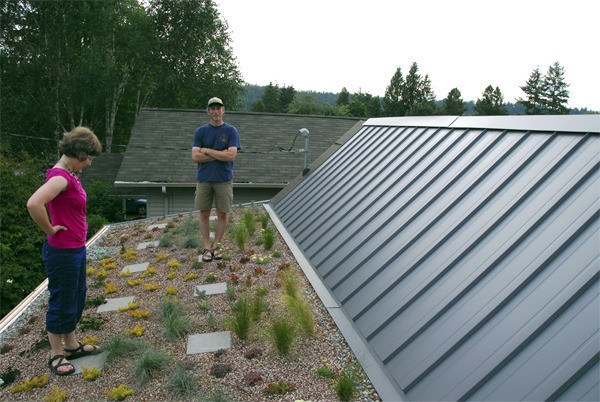It’s not quite finished yet, but the new front porch on Toby Maloy’s Carnation home is a great source of pride to him. Someday, he hopes, it will also be a sort of advertisement.
Maloy, with the help of his wife, Jennifer Resler, and many friends and colleagues, recently built, filled and planted what may be Carnation’s first-ever green roof. It’s the first one permitted, anyway, and Maloy’s first, despite years of trying to convince clients to build one.
“I’ve always been interested in green roofs,” said Maloy, a contractor and owner-operator of Seamus Woodworks.
As a contractor, though, he couldn’t persuade people to, essentially, landscape their roofs. Maintenance concerns, he said, outweighed all the benefits, even though “green roofs do not cause leaks,” he said.
However, he admits, “If you have a leak, you’ve just buried it in six inches of soil.”
Green roofs must be built to be more sturdy than a typical roof —Maloy estimates his added another 35 to 40 pounds per square foot to the overall roof weight—but a properly-built green roof is actually less likely to leak. The roofing membrane installed to prevent leaks in any roof is, in a green roof, entirely protected from exposure to sunlight, Maloy said. It also should be a thicker material than typical membranes.
That’s only one small benefit of a green roof, though. It also lets you incorporate nature into your home, cool the area beneath it in the summer and keep it warmer in the winter, while still upping the environmentally friendly factors, Maloy says. A green roof will help absorb rainwater and reduce stormwater runoff, while effectively reducing the impermeable surface area on your property.
“That area is no longer productive in the ecosystem, once you plop your house down on it,” Maloy said.
Officially, a green roof does not count toward reducing impermeable surface area, but Maloy is hopeful that changes as technology improves and green roofs become more popular.
Green roofs aren’t a passing trend, he notes. “They go way back,” centuries in fact. Sod roofs and sod houses have been built for countless years in Scandinavian countries, and settlers from those countries brought them to the midwest, as well. “That’s kind of where it came from,” he said.

A special soil mix, 80 percent highly absorbent but lightweight materials like pumice and lava rock, 10 percent compost and 10 percent peat moss is the growth medium of choice for green roofs today, says Maloy. It also makes the roof easier to weed, which is a necessary part of the maintenance. For his own green roof, Maloy bought three yards of the blend from a commercial supplier, and used a lift to haul it up to his roof, bucket by bucket.

Looking over what’s left of about $400 in plants for his green roof, Toby Maloy holds a bowl of some plant pieces that broke off during the planting. Many of the remnants can still grow, he said, and some large green roof projects are actually planted entirely with scraps like these.

An assortment of sedums and other drought-tolerant succulents were left over from June 16, when Toby and Jennifer, with the help of their 3 year-old son Arrow, planted their new green roof. About 150 plants went onto the roof, including an almost-black type of clover, and, just for fun, chives. Arrow’s contribution was that “he slept through the entire planting,” Toby said, “—and that really helped us get it done!” added Jennifer.


